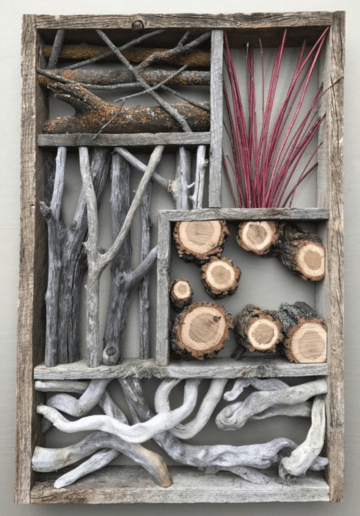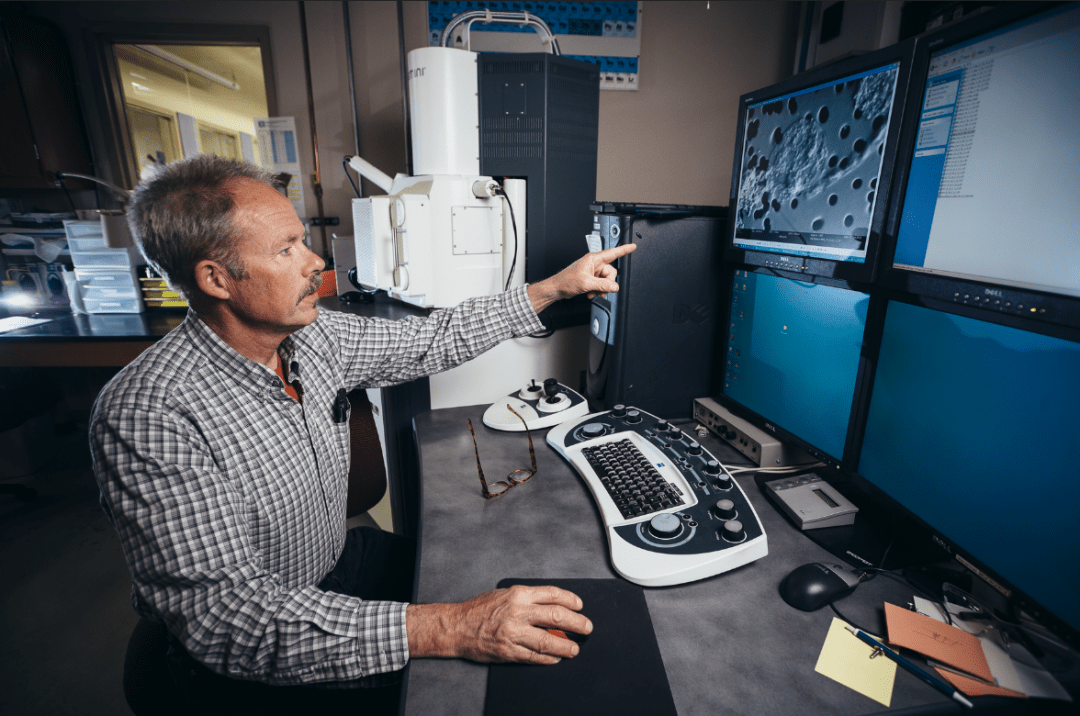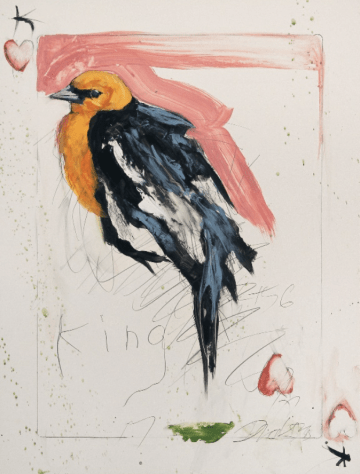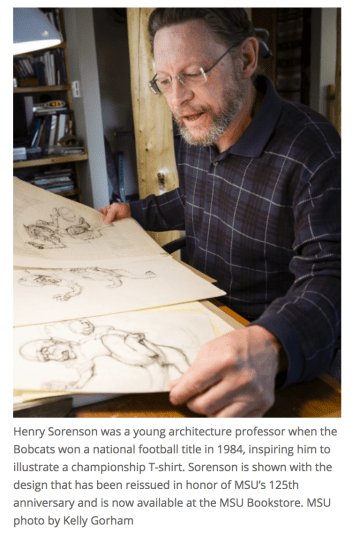Be a Part of the Emerson Lawn!

- At our front office, Monday-Friday from 9-5
- Over the phone: 406-587-9797 x100
- Mailed to 111 South Grand Avenue, Bozeman 59715

June Art Walk Featured Artist: David Lustig
Opening Reception: Friday, June 8th 6-8pm
Mixed media artist David Lustig has quite literally come back to his roots. When still a young boy he discovered a love of nature and art as he played in and sketched the woods around him. He attended Montana State University and graduated with a degree in landscape design, which gave him both the language and the skills to work with the local flora. He tried his hand at many different types of art media over the years, but it wasn’t until recently that he attempted a long-pondered idea that became the art he creates today.

Using natural elements like roots, twigs and branches, David emulates the organic forms found in nature. The materials for each piece are sustainably collected locally and then carefully manipulated into simple yet elegant forms. In one piece, gnarled roots intertwine to form the branches of a tree, and in another willow twigs in shades of red and yellow recreate the deceptively simple interplay of color and texture found along a creek bank. Each piece speaks of a long held respect for and love of nature, and allows the collector to bring a bit of the natural world inside their home. David’s sculptural, organic art pieces will be on display at Altitude Gallery during downtown Bozeman’s June Art Walk.
The reception will be held in Altitude Gallery, at 134 E. Main Street. Call 406-582-4472 or info@altitudegallerybozeman.com for more information.
In the fight against an invasive fish that has decimated Yellowstone National Park’s iconic cutthroat trout, a technology developed at Montana State University could help park managers more effectively locate fish for removal.
During recent flights over Yellowstone Lake in a small aircraft, MSU’s device was able to identify clusters of two or more lake trout to a depth of at least 26 feet, according to Joe Shaw, professor of electrical engineering in MSU’s Norm Asbjornson College of Engineering and co-author of a May 20 article describing the findings in the journal Applied Optics.
The lidar technology — so called because it operates similarly to radar by measuring reflections of harmless, non-visible pulses of laser light — could be used to more easily determine areas to target with gill netting, the main method that park managers use to capture non-native lake trout in an attempt to reverse the decline of native Yellowstone cutthroat trout, according to co-author and Yellowstone fisheries biologist Patricia Bigelow.
“It has the potential to be a great tool,” Bigelow said.

Lake trout, thought to have been introduced illegally into Yellowstone Lake in the 1980s, are efficient predators that eat a significant number of cutthroat trout, whose native range in Montana, Idaho and Wyoming has shrunk considerably in recent decades. Since lake trout were first observed in 1994 in the park’s largest water body — considered a stronghold of the remaining cutthroat trout population — the number of spawning cutthroat trout has declined nearly 99 percent in some areas.
The National Park Service spends $2 million annually to remove hundreds of thousands of lake trout from Yellowstone Lake. Boats position gill nets on the lake bottom and then haul entangled fish aboard, where the lake trout are killed and cutthroats released. The most effective time to cull the largest and most voracious lake trout is during spawning, when the fish group in relatively shallow water near the shore, according to Bigelow.
Currently, park managers locate the spawning areas using small transmitters surgically implanted into about 200 large lake trout. The transmitters emit distinct sound frequencies that park staff detect with boat-mounted acoustic sensors as they circle the lake. But because the lake is large and the boats must go slowly to operate the sensors, it can take days to survey the lake and locate the spawning fish and then relay the information to the gill netting boats, Bigelow said.
“Two big plusses of using he lidar tool are that we could fly the whole lake in a couple hours and that we could detect any fish in shallow water, not just the ones that have transmitters,” which could save time and money, Bigelow said.
Shaw said he was excited to see the project come to fruition after more than a decade of research and development. Prior to joining the faculty in MSU’s Department of Electrical and Computer Engineering in 2001, he collaborated with National Oceanic and Atmospheric Administration physicist and co-author Jim Churnside on the use of lidar for detecting ocean fish. When Shaw presented the research shortly after arriving at MSU, someone mentioned that it might also be applied to lake trout in Yellowstone, he recalled.
In 2004, Shaw borrowed NOAA’s fish-detecting lidar device — which was so large that it had to be flown in a multi-propeller plane — and conducted a trial run over Yellowstone Lake. The results were promising enough that park managers decided to send gill netting boats to a remote part of the lake where they otherwise seldom operated, according to Bigelow. The boats captured many lake trout in a short time, she said.
Contracting the large plane was expensive, however. So Shaw began to design a much smaller version of the lidar device that would be more affordable and more appropriate for flying over the lake. “The goal was to build something that would fit in a single-engine Cessna,” he said.
Shaw’s team, which included then-MSU doctoral student and co-author Michael Roddewig, succeeded in doing that by using an efficient laser produced by local photonics company Quantel. During flights in a small aircraft over Yellowstone Lake in 2015 and 2016, the team demonstrated that the new device could effectively locate groups of spawning lake trout. The publishing of the results, Shaw noted, coincided almost to the day with the invention of the laser 58 years ago.
Shaw said the tool could continue to be improved and incorporated into Yellowstone’s operations. For instance, producing maps of the spawning locations currently requires sophisticated data processing, but a more user-friendly interface could be developed. The tool could also be adapted for other uses, including studying layers of plankton or sediments suspended in lakes or even rivers, he said.
“I’m delighted that we can do something useful for the Yellowstone ecosystem, because it’s a special place,” Shaw said.
Montana State University scientists have found a new lineage of microbes living in Yellowstone National Park’s thermal features that sheds light on the origin of life, the evolution of archaeal life and the importance of iron in early life.
Professor William Inskeep and his team of researchers published their findings May 14 in the scientific journal Nature Microbiology.
"The discovery of archaeal lineages is critical to our understanding of the universal tree of life and evolutionary history of the Earth," the group wrote. "Geochemically diverse thermal environments in Yellowstone National Park provide unprecedented opportunities for studying archaea in habitats that may represent analogues of early Earth."
Archaea is one of the three domains of life, the others being bacteria and eukaryotes. Like bacteria, archaea are single-cell organisms. The eukaryote domain contains more cellularly complex organisms, such as humans, other animals, plants and fungi.
The scientists called the new archaeal lineage Marsarchaeota after Mars, the red planet, because these organisms thrive in habitats containing iron oxides. Within Marsarchaeota, they discovered two main subgroups that live throughout Yellowstone and thrive in hot, acidic water where iron oxide is the main mineral. One subgroup lives in water above 122 degrees Fahrenheit, and the other lives in water above 140 to 176 degrees. The water is about as acidic as grapefruit juice. Their microbial mats are red because of the iron oxide.

"It's interesting that the habitat of these organisms contains (iron) minerals similar to those found on the surface of Mars," Inskeep said.
He added that microbes produce iron oxide, but the Marsarchaeota do not. They might be involved in reducing iron into a simpler form, "which is important from an early Earth standpoint. Iron cycling has been implicated as being extremely important in early Earth conditions."
The Marsarchaeota live fairly deep in microbial mats, but they still require low levels of oxygen, Inskeep said. The subgroups are so abundant that, together, they can account for as much as half of the organisms living within a single microbial mat.
The scientists studied microbial mats throughout Yellowstone. Microorganisms in these “microbial beaver dams” produce iron oxide that creates terraces, which, in turn, block streams. As water (only a couple of millimeters deep) runs over the terraces, oxygen is captured from the atmosphere and supplied to the Marsarchaeota.
"Physics comes together with chemistry and microbiology," Inskeep said. "It's like a sweet spot of conditions that this group of organisms likes."
In addition to learning more about life on early Earth and the potential for life on Mars, Inskeep said the research can help scientists understand more about high-temperature biology.
"Knowing about this new group of archaea provides additional pieces of the puzzle for understanding high-temperature biology," he said. "That could be important in industry and molecular biology."
The work that resulted in the Nature Microbiology paper was the culmination of research that took place over the past decade, said Inskeep, who has studied the geochemistry and microbiology of Yellowstone's high-temperature environments for the last 20 years. Inskeep is a professor of geomicrobiology in MSU's Department of Land Resources and Environmental Sciences in the College of Agriculture and co-founder of MSU's Thermal Biology Institute.
The lead authors of the Nature Microbiology paper earned their doctorates at MSU and were part of NSF's Integrative Graduate Education and Research Traineeship (IGERT) program while at MSU. Zackary Jay is now a postdoctoral researcher in the Department of Chemical and Biological Engineering in the Norm Asbjornson College of Engineering and the Center for Biofilm Engineering at MSU. Jacob Beam is now a postdoctoral researcher at Bigelow Laboratory for Ocean Sciences at East Boothbay, Maine.
“In the end, after many years of work, it’s exciting, and a relief, to have our team’s work recognized and published, particularly in a high impact journal,” Jay said.
Other co-authors were Mensur Dlakic from MSU's Department of Microbiology and Immunology in the College of Letters and Science and College of Agriculture; Douglas Rusch from the Center for Bioinformatics at Indiana University; and Mark Kozubal from the Thermal Biology Institute, MSU's Department of Land Resources and Environmental Sciences, and Sustainable Bioproducts in Bozeman.
The Yellowstone research was a collaboration involving the Thermal Biology Institute, the Montana Agricultural Experiment Station (MAES) and the Yellowstone Center for Resources (National Park Service). Funding came from IGERT, the Pacific Northwest National Laboratory and MAES. The U.S. Department of Energy Joint Genome Institute in Walnut Creek, California, sponsored the genetic sequencing.
The Sandbox Project is one of many the Bozeman Kiwanis Club provides to give back to the community through various outreach programs. Other projects include: Eliminate, which through Kiwanis International has made great strides to eliminate maternal neonatal tetanus. Local support is also provided for Eagle Mount Camp Braveheart, Hope and the Holidays, Kids in Crisis Backpacks, Fix-Up Festival, playground equipment for schools, park pavilions throughout the city, Thrive, and many others. For more information about the Bozeman Kiwanis Club please go BozemanKiwanis.com or “Bozeman Kiwanis” on Facebook.
Exhibition Dates: Friday June 8th – July 11th
Opening Reception: Friday June 8th from 6 – 8 PM, as part of the Bozeman Art Walk

Birds of a feather flock together for this diverse group exhibition. Visions West Contemporary welcomes the summer season with the show Levitation. This show curates works centered around the form and habits of birds in relation to the world. Artists Michael Dickter, Shelley Reed, Troy Abbott, and Kevin Chupik have created works inspired by the freedom, beauty and elusive nature of the avian form. The result is an intriguing and striking flight.
Each artist brings their perspective on what it means to levitate like a bird, whether it is through personal or shared history. Michael Dickter brings mixed media paintings that fuse the shared nostalgia from a deck of cards and birds together. He reimagines each card with the appropriate birds for the eight of clubs, or a regal portrait for the king of hearts, creating a full flock in the deck.
Shelley Reed masterfully combines history and animalia through her cinematic, black and white paintings. Reed precisely pairs the symbolic cultural language from European Baroque paintings of the 17th and 18th century to create compelling contemporary pieces. Her work can be seen in several museums across the country. Her most recent acquisition by the 21C Art Hotels, a 57 foot long painting, can be found in the lobby of their Nashville hotel.
Miami- based technology artist, Troy Abbott, adds a unique digital element to the show with his prompt to create unique, mixed media sculptures. His piece, Social Media, combines old, forgotten objects – such as a wooden chicken coop – and modern video installation. Abbott personifies these chatting hens to be like ourselves on social media, cleverly melding old with the new.
Visions West Contemporary also introduces a new artist to their roster, Kevin Chupik. Chupik pulls from a life of experience and creates his own narrative with a vibrant color palette and playful compositions, echoing the joy of childhood.
This June show marks the beginning of summer in Bozeman and the beginning of the seasonal Art Walks. The exhibition’s opening will be in conjunction with the Art Walk on Friday June 8th, from 6 – 8 PM. The show will be up through July 11th.
On July 4th, 2018 Reach Inc. will host their 11th Annual Race for Independence. Reach is a local non-profit that provides residential, vocational, and transportation supports to adults with developmental disabilities. This joyful celebration benefits the people Reach serves, and will include a 10K, 5K, 1K, and an assortment of exciting raffle prizes.
The course is mostly on flat trails in the beautiful Cherry River Fishing Access and the East Gallatin Recreation Area. These paths offer sweeping views of the breathtaking Gallatin Valley landscape. Because the trail narrows in some sections, runners are encouraged to stay mindful of their surroundings, and allow faster participants to pass. Walkers are welcome to join the fun. No dogs, please.

The 10K begins at 8:00AM, the 5K at 8:15AM, and the 1K at 8:25AM. Bib timing will be used. In order to prevent vehicle traffic on the course, attendees are requested to arrive before 8:00AM. The race begins and ends at the Reach Work Center, which is located at 322 Gallatin Park Drive, Bozeman, MT 59715. Parking will be available at surrounding businesses.
Registration is $25 for the 10K/5K, and $15 for the 1K. Optional, snazzy, short-sleeved, technical tee shirts will be sold for $10. You can register online at www.reachinc.org, or in person at the Reach Work Center Monday through Friday, 8:00AM-5:00PM. Reach Inc. is thrilled that the Race for Independence will be part of the first Big Sky Wind Drinkers Grand Prix Series.
A team of over 60 volunteers come together to make this event possible. If you are interested in getting involved, please contact Community Relations Specialist, Jamie Balke, at jbalke@reachinc.org or (406) 587-1271 to learn more about volunteer opportunities. You are also welcome to contact Community Relations and Development Director, Dee Metrick, with any questions at dee@reachinc.org or 406-587-1271.
Henry Sorenson still recalls vividly the energy he felt on campus when Montana State University unexpectedly won a Division 1-AA national football championship in 1984.
The architecture professor, who specializes in architectural drawing, was among the fans that followed the ‘Cats in their unlikely journey from the bottom of the Big Sky to the national title nearly 34 years ago. So, he commemorated the enthusiasm in the Bobcat community in the best way he knew how. He designed a T-shirt featuring a cartoon image of the MSU mascot wearing the number one.

That shirt, popular when it was first designed, has been reissued as part of MSU’s 125th anniversary celebration and is now available from the MSU Bookstore, according to Julie Kipfer, MSU’s director of marketing.
“What better way to celebrate the 125th anniversary than to highlight one of our professor’s iconic designs,” Kipfer said. “Re-launching this retro T-shirt is a great way to introduce today’s students to MSU’s heritage and engage with alumni who fondly remember that time.”
The reissue is particularly meaningful for Sorenson, who is known nationally for his hand-drawn architectural renderings as well as for his architectural photography. His rural landscape photograph taken near Fort Benton recently won first place in the American Institute of Architects Photography Competition, and he won a juror award for a watercolor painting in the Architecture in Perspective competition of the American Society of Architectural Illustrators.

But as a hobby, Sorenson has designed T-shirts since he was an undergraduate at the University of Florida, a university with a great football tradition. So it was quite a contrast when Sorenson arrived at MSU in 1983 to implement the School of Architecture’s architectural graphics program and the Bobcat football team won just one game in the season. Sorenson said the Bobcats’ Cinderella season the following year “was unbelievable.” He can still remember sitting in the stands on an 18-degree-below-zero day when the Bobcats beat a visiting team from Arkansas State to advance to the national championship game.
“It was an amazing thing to win a national championship,” Sorenson said. “I thought I’d draw a championship shirt for fun.”
With the 125th anniversary this year, he suggested to the committee planning the yearlong celebration that the championship shirt might be a way to recall the university’s last football championship, and the committee agreed.
Sorenson’s shirt, which costs $17.95, can also be ordered online at http://www.msubookstore.org/MerchDetail.aspx?MerchID=1492677&num=0&start=1&end=20&type=1&CategoryName=T-Shirts%20and%20Tanks&CatID=27865&Name=T-Shirts%20and%20Tanks#.Wt-5INPwZTa
In the meantime, Sorenson is still teaching MSU architecture students the importance of hand drawing, which is a lost art in many programs but an important part of MSU’s curriculum.
“You can’t replace drawing,” Sorenson said. “You think differently when you are drawing than when you are sitting in front of a computer.”
To learn more about Sorenson’s Bobcat shirt, go to http://www.msubookstore.org/ and click on the Retro Cat T-shirt.
The Montana Fish, Wildlife & Parks Anaconda watercraft inspection station intercepted a boat carrying zebra mussels Friday. The cabin cruiser was being transported from Ohio to Puget Sound in Washington.
The inspection station reported that many mussels were found in the boat’s gimbal area, the trim tabs and several crevices.
The boat was wrapped in shrink wrap, and inspectors hot-washed the exterior of the boat to the best of their ability. The inspectors were not able to flush the motors, bilge pump or any other part of the boat.
The transporter of the boat was not the owner of the boat, and he did not have keys to the boat.Officials in Idaho and Washington were notified. The Washington Department of Fish & Wildlife will follow up with the vessel to wash and possibly quarantine it.
FWP reminds all those transporting motorized or nonmotorized boats into Montana to have their watercraft inspected before launching. Boat owners are required to stop at all open watercraft inspection stations. To find a watercraft inspection station visit www.cleandraindrymt.com.

Ted Waddell was born and raised in Laurel, Montana, a small railroad community west of Billings. His new book, Memories of Childhood, tells of an idyllic rural childhood with caring parents, close friends, farm animals, and numerous boyhood adventures.
Before cell phones and video games, growing up in the west required exploration fueled by imagination. Nature played a major role as a fertile playground and a stern teacher. The humble stories relate lessons learned in the joys and heartaches of growing up in a rural environment. Waddell recalls a simpler life, although not necessarily an easier one, as young boy he worked many colorful jobs for low wages.
The fourteen playful illustrations in the book are splendidly populated with chickens and cows, boys and dogs, threshing machines and tractors. Readers will find a common thread in these Montana memories of hunting and fishing, farm choirs and fall harvest.
Parents, and particularly grandparents, will enjoy reading these stories to young people. Memories of Childhood is a book of memories worth sharing. Collectors of Ted Waddell’s paintings, prints and other books will enjoy this addition if this thoughtful boyhood memoir.
Waddell has three other children’s books based on his beloved Bernese Mountain Dogs, Tucker Tees Off (2016), Tucker’s Seasonal Words of Wisdom (2015), and Tucker Gets Tuckered (2006).
Theodore Waddell: My Montana—Paintings and Sculpture, 1959–2016, by Rick Newby was published in 2017. Richly illustrated with the artist’s work, as well as images from his personal archive, My Montana, traces Waddell’s early influences and the development of a career that lead to becoming one the West’s most recognized and celebrated contemporary artist. My Montana is published by Drumlummon Institute of Helena, MT, and is distributed by the University of Oklahoma Press.
Waddell divides his time between a studio in Sheridan, Montana, and a home in Hailey, Idaho, he shares with wife, writer and photographer Lynn Champion. In 2015, Theodore Waddell was honored with the Montana Governor’s Award for the Arts.
News Comments
Thank you
Open Auditions for Annie
Monday, Sep. 16, 2024
I’m at the Bozeman airport where your painting, “Blowing East” is displayed. It’s absolutely gorgeous! Bravo, Marci!!
The Artists’ Gallery in Bozeman’s Emerson Cultural Center May Exhibits
Sunday, Jun. 30, 2024
This is so typical of a sign in, which we should not have to do to check if we or some one in our party got a permit. I have been working or "creating an account" for 30 minutes and just get the same ...
Smith River permit drawing results available
Sunday, Mar. 10, 2024
I have struggled with this podcast and my own participation therein, the event itself obviously traumatic, but beyond that my inability to reach anyone and convey anything resembling truth. The person ...
Billings, MT Case Becomes True Crime Podcast | 'An Absurd Result'
Marktokarski
Saturday, Jan. 20, 2024